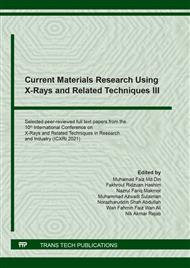[1]
S. Sarkar, S. Bandyopadhyay, A. Larbot, and S. Cerneaux, New clay–alumina porous capillary supports for filtration application, J. Memb. Sci. 392 (2012)130–136.
DOI: 10.1016/j.memsci.2011.12.010
Google Scholar
[2]
R. A. Shkrabina, B. Boneckamp, P. Pex, H. Veringa, and Z. R. Ismagilov, Porous structure of alumina ceramic support for gas separation membranes, II. Study of porous structure of ceramic composition, React. Kinet. Catal. Lett. 54 (1995) 193–201.
DOI: 10.1007/bf02071198
Google Scholar
[3]
D.A. Ivanov, S.D. Shlyapin, G.E. Val'yano, and L.V. Fedorova, Structure and physicomechanical properties of porous ceramic based on Al2O3 prepared using a filtration combustion method, Refract. Ind. Ceram. 58 (2018) 538–541.
DOI: 10.1007/s11148-018-0140-5
Google Scholar
[4]
Z. Sun, C. Lu, J. Fan, and F. Yuan, Porous silica ceramics with closed-cell structure prepared by inactive hollow spheres for heat insulation, J. Alloys Compd. 662 (2016) 157–164.
DOI: 10.1016/j.jallcom.2015.12.061
Google Scholar
[5]
Q. B. Chang, X. Q. Liu, X. Wang, Y. Q. Wang, and J. E. Zhou, Preparation of porous ZrO2-Al2O3 composite ceramic with high strength and good corrosion-resistance, Adv. Mat. Res. 197 (2011) 1545–1548.
Google Scholar
[6]
J. Cao, X. Dong, L. Li, Y. Dong, and S. Hampshire, Recycling of waste fly ash for production of porous mullite ceramic membrane supports with increased porosity, J. Eur. Ceram. Soc. 34 (2014) 3181–3194.
DOI: 10.1016/j.jeurceramsoc.2014.04.011
Google Scholar
[7]
F. Jiang, L. Zhang, E. Mukiza, Z. Qi, and D. Cang, Formation mechanism of high apparent porosity ceramics prepared from fly ash cenosphere, J. Alloys Compd. 749 (2018) 750–757.
DOI: 10.1016/j.jallcom.2018.03.303
Google Scholar
[8]
B. C. A. Pinheiro and J. N. F. Holanda, Obtainment of porcelain floor tiles added with petroleum oily sludge, Ceram. Int. 39 (2013) 57–63.
DOI: 10.1016/j.ceramint.2012.05.092
Google Scholar
[9]
C. Vieira and S. Monteiro, Incorporation of solid wastes in red ceramics: an updated review, Materia (Rio de Janeiro). 4 (2009) 881-905.
DOI: 10.1590/s1517-70762009000300002
Google Scholar
[10]
S. Huang, F. Chang, S. Lo, M. Lee, C. Wang and J. Lin, Production of lightweight aggregates from mining residues, heavy metal sludge, and incinerator fly ash, Journal of Hazardous Materials. 144 (2007) 52-58.
DOI: 10.1016/j.jhazmat.2006.09.094
Google Scholar
[11]
S. Amin, E. Abdel Hamid, S. El-Sherbiny, H. Sibak and M. Abadir, The use of sewage sludge in the production of ceramic floor tiles, HBRC Journal. 14 (2018) 309-315.
DOI: 10.1016/j.hbrcj.2017.02.002
Google Scholar
[12]
L. Gredmaier, C. Banks and R. Pearce, Calcium and sulphur distribution in fired clay brick in the presence of a black reduction core using micro X-ray fluorescence mapping, Construction and Building Materials. 25 (2011) 4477-4486.
DOI: 10.1016/j.conbuildmat.2011.03.054
Google Scholar


